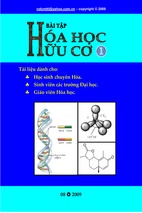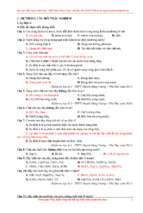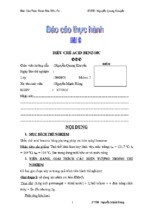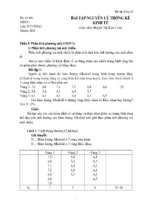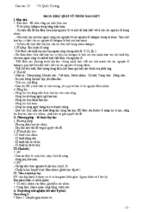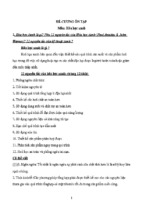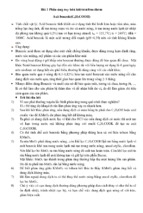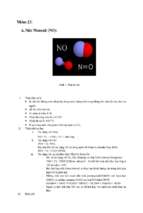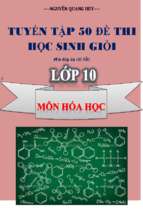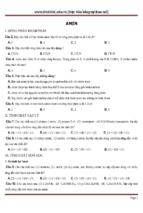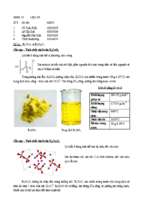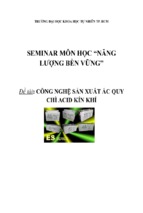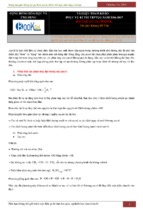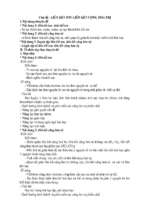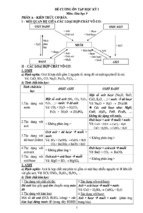Organic Chemistry II as a Second Language, 2e Second Semester Topics - David R. Klein
ORGANIC CHEMISTRY II
AS A SECOND
LANGUAGE
DR. DAVID R. KLEIN
Johns Hopkins University
JOHN WILEY & SONS, INC.
SENIOR ACQUISITIONS EDITOR
EXECUTIVE PUBLISHER
MARKETING MANAGER
PRODUCTION MANGER
PRODUCTION EDITOR
CREATIVE DIRECTOR
SENIOR DESIGNER
SENIOR EDITORIAL ASSISTANT
PROJECT MANAGEMENT SERVICES
COPYEDITOR
Kevin Molloy
Kaye Pace
Amanda Wygal
Pam Kennedy
Sarah Wolfman-Robichaud
Harry Nolan
Kevin Murphy
Cathy Donovan
Pam Lininger/Matrix Publishing Services
Betty Pessagno
This book was set in 10/12 Times Roman by Matrix Publishing and printed and bound by Courier
Westford. The cover was printed by Courier Westford.
This book is printed on acid-free paper. ⬁
Copyright © 2006 John Wiley & Sons, Inc. All rights reserved. No part of this publication may be
reproduced, stored in a retrieval system or transmitted in any form or by any means, electronic,
mechanical, photocopying, recording, scanning or otherwise, except as permitted under Sections 107
or 108 of the 1976 United States Copyright Act, without either the prior written permission of the
Publisher, or authorization through payment of the appropriate per-copy fee to the Copyright
Clearance Center, Inc. 222 Rosewood Drive, Danvers, MA 01923, website www.copyright.com.
Requests to the Publisher for permission should be addressed to the Permissions Department, John
Wiley & Sons, Inc., 111 River Street, Hoboken, NJ 07030-5774, (201)748-6011, fax (201)748-6008,
website http://www.wiley.com/go/permissions.
To order books or for customer service please, call 1-800-CALL WILEY (225-5945).
ISBN-13 978- 0-471-73808-4
ISBN-10 0-471-73808-5
Printed in the United States of America
10 9 8 7 6 5 4 3 2 1
TABLE OF CONTENTS
Chapter 1
THE SKILLS YOU NEED
1
1.1 The Goal of This book 1
1.2 Mechanisms Are Your Keys to Success
Chapter 2
INTRO TO IONIC MECHANISMS
2.1 Curved Arrows 4
2.2 The Basic Moves 8
2.3 Combining the Basic Moves
Chapter 3
3.1
3.2
3.3
3.4
3.5
3.6
3.7
3.8
3.9
16
ELECTROPHILIC AROMATIC SUBSTITUTION
KETONES AND ALDEHYDES
22
43
NUCLEOPHILIC AROMATIC SUBSTITUTION
Criteria for Nucleophilic Aromatic Substitution
SNAr Mechanism 86
Elimination-Addition 90
Mechanism Strategies 96
Chapter 5
5.1
5.2
5.3
5.4
5.5
4
Halogenation and the role of Lewis Acids 23
Nitration 28
Friedel-Crafts Alkylation and Acylation 31
Sulfonation 38
Modifying the Nucleophilicity of the Nucleophile
Predicting Directing Effects 46
Identifying Activators and Deactivators 59
Predicting and Exploiting Steric Effects 69
Synthesis Strategies 76
Chapter 4
4.1
4.2
4.3
4.4
2
83
83
98
Preparation of Ketones and Aldehydes 98
Stability and Reactivity of the Carbonyl 102
H-Nucleophiles 104
O-Nucleophiles 109
S-Nucleophiles 122
iii
iv
5.6
5.7
5.8
5.9
TABLE OF CONTENTS
N-Nucleophiles 131
C-Nucleophiles 139
Some Important Exceptions to the Rule 148
How to Approach Synthesis Problems 152
Chapter 6
6.1
6.2
6.3
6.4
6.5
6.6
General Rules 160
Acyl Halides 167
Anhydrides 176
Esters 179
Amides and Nitriles
Synthesis Problems
Chapter 7
7.1
7.2
7.3
7.4
7.5
7.6
7.7
7.8
7.9
159
188
194
ENOLS AND ENOLATES
203
Keto-Enol Tautomerism 205
Reactions Involving Enols 210
Making Enolates 213
Haloform Reactions 216
Alkylation of Enolates 219
Aldol Reaction and Aldol Condensation 223
Claisen Condensation 230
Decarboxylation Provides Some Useful Synthetic Techniques
Michael Reactions 245
Chapter 8
8.1
8.2
8.3
8.4
8.5
8.6
8.7
CARBOXYLIC ACID DERIVATIVES
AMINES
253
Nucleophilicity and Basicity of Amines and Amides
Preparation of Amines through SN2 Reactions 255
Preparation of Amines through Reductive Amination
Preparation of Amines from Amides 263
Acylation of Amines 267
Reactions of Amines with Nitrous Acid 271
Aromatic Diazonium Salts 274
Answer Key
Index 311
277
253
259
238
CHAPTER
1
THE SKILLS YOU NEED
1.1
THE GOAL OF THIS BOOK
There are a lot of reactions that you will learn this year. Perhaps you could try to memorize them.
Some people are good at that. But rather than memorizing, you would actually be better off if you
tried to focus on building your skills. You will need certain skills in order to do well in this course.
In this book, we will focus on those skills.
Specifically, you will learn the skills that you need to do three very important types of
problems:
1. Proposing a mechanism
2. Predicting products
3. Proposing a synthesis
As you progress through the course, you will soon realize that it is not enough just to learn the
reactions. To do well in this course, you MUST learn how to approach and solve these three types
of problems. You must become a master of very specific skills. These skills will guide you in solving problems. These three types of problems represent the core of an organic chemistry course. If
you master the skills you need, you will do very well.
Each chapter in this book will focus on the skills that you need in order to master a particular
topic. The chapters in this book are designed to map out fairly well onto the chapters in your textbook. For instance, when you are learning about carboxylic acid derivatives, there will be a chapter in this book with the same title.
We will not have enough space to cover every topic in your textbook. This supplement is not
designed to replace your textbook or your instructor. Rather, it is meant to provide you with the
core skills that will allow you to study more efficiently.
Although we will focus on three major types of problems, we must place the major emphasis on
mechanisms. Mechanisms are your keys to success in organic chemistry. If you master the mechanisms,
you will do very well in the class; if you don’t master them, you will do poorly. It is hard to talk about
synthesis problems if you don’t know the reactions well enough (and the same is true for predicting
products). That is why Chapter 2 is devoted to laying the foundation you need to master mechanisms.
That chapter is important. So, even though it won’t correspond to a specific chapter in your textbook,
make sure to go through Chapter 2 anyway.
In Chapter 2, we will see that mechanisms follow a small number of basic themes and ideas. By
focusing on these basic themes, you will see the common threads between mechanisms that would otherwise appear to be very different. This approach will minimize the need for memorization. In fact, we
will soon argue that students who focus on memorization will miss problems that are trivial when you
understand the basic concepts. This book will provide you with the fundamental language and tools
that you need in order to master mechanisms. And while we are at it, we will work on the skills you
need to solve synthesis problems and predicting products as well.
1
2
CHAPTER 1
THE SKILLS YOU NEED
1.2 MECHANISMS ARE YOUR
KEYS TO SUCCESS
What are mechanisms, and why are they so important?
To understand the important role that mechanisms play, let’s consider an analogy. I recall the
time that I had to teach my children how to put on their shoes. It is amazing how many steps are
involved when tying your shoelaces. Next time you tie your shoelaces, think about how many individual steps your hands are doing, and think about how you would explain each of these steps to
someone who never learned how to tie their own shoes. It is a difficult thing to teach. I am embarrassed to say that my first response was to take the easy road—I bought them shoes with Velcro straps. I had temporarily solved my problem because the new shoes required so few steps to
put on.
The end result (a child wearing shoes) looks the same regardless of the type of shoe used. But
the process of getting the shoes on is very much dependent on the type of shoe. In particular, the
number of steps involved to compete the process is vastly different from one type of shoe to the
other. The same is true with reactions. All reactions involve steps to get from starting materials to
products. Some reactions proceed through a lot of steps, while others go through just a few steps.
A detailed list of steps that a reaction follows is called a mechanism.
When two compounds react with each other to form new and different products, we try to understand how the reaction occurred—what are the individual steps in the process? Every step involves the flow of electron density; electrons move to break bonds or to form new bonds. Mechanisms illustrate how the electrons move during each step of a reaction. The flow of electrons is
shown with curved arrows, for example:
Cl
−Cl
H
O
H
H
O
H
H
O
H
O
H
The curved arrows in each of the three steps above show us how the reaction took place. You
should think of a mechanism as the “book-keeping of electrons.” Just like an accountant will do
the book-keeping of a company’s cash flow (money coming in and money going out), so, too, a reaction mechanism is the book-keeping of the electron-flow in each step of a reaction.
In my previous book (Organic Chemistry as a Second Language: Translating the Basic Concepts), we saw that bond-line drawings (the way we draw molecules in organic chemistry—see the
reaction above) are the “hieroglyphics” of organic chemistry. We saw that these drawings focus on
the electrons (the atoms themselves are generally not drawn, but are implied). Each line in the drawing represents a bond, which shows you where the electrons are. Look at the mechanism above, and
in your mind, think of it as a sentence. The drawings of the molecules (the bond-line drawings) represent the nouns of the sentence. The curved arrows are the verbs of the sentence. So a mechanism
is essentially a sentence. It is truly a language, and you need to learn how to combine the nouns
and verbs, just as you do in any other language. In my previous book, we focused on the nouns of
the sentences—we focused on molecules. In this book, we focus on the verbs. Imagine learning
French without learning any verbs. You wouldn’t be able to get out a single sentence!!!!
So, if you want to master mechanisms, then you really need to master curved arrows, which are
the verbs of our language. You need to know when and where to draw curved arrows. In other
words, you need to learn to predict how electrons flow.
Once you appreciate the idea that electrons move in predictable ways, you will begin to see similarities in all of the mechanism in this course. As an analogy, consider the way water flows. You
1.2 MECHANISMS ARE YOUR KEYS TO SUCCESS
3
know that, because of gravity, water flows to the lowest spot. That is true on a mountain, on a
bumpy road, on a roof, and so on. In each situation, you could probably predict how water would
flow on the terrain by simply inspecting it and looking for grooves that lead to the lowest point.
Simple, right? Well, imagine if you had a friend who did not understand that water always flows
to the lowest spot. Your friend would be absolutely amazed at your ability to predict how the water would flow in every (seemingly different) situation. After all, a roof is certainly a different situation from a bumpy road. But in fact, the situations are not all that different when you understand
the one simple concept that water flows to the lowest point.
Similarly, the flow of electrons can be predicted by understanding just a few simple concepts.
If you really want to make your life miserable, then you could memorize every single mechanism
in the course. But that would be silly—that would be like your friend (who does not know how water flows) trying to memorize every different situation (the roof, the mountain, the road, etc.). Your
friend might have a good memory, but if he does not understand how water flows, he will be completely stumped when he sees a new terrain that he has not memorized. Without knowing the one
guiding principle, he would be lost. But when you know the guiding principle, it is trivial to make
the prediction of how the water will flow on ANY new terrain.
When you understand a mechanism, you will understand why the reaction took place, why the
stereocenters turned out the way they did, and the like. If you do not understand the mechanism,
then you will find yourself memorizing the exact details of every single reaction. Unless you have
a photographic memory, that will be a very difficult challenge, and as we have just seen, you will
not be able to extrapolate to situations that you have never seen. By understanding mechanisms,
you will be able to make more sense of the course content, you will be able to better organize all
of the reactions in your mind, and you will be able to propose mechanisms in new situations.
At this point, you might be wondering why everyone always says that organic chemistry is all
about memorization. Well, the truth is, they are all WRONG. Before you can master organic chemistry, you must let go of the myth that so many former students have engrained in your psyche.
There is actually very little memorization in organic chemistry. And if you try to replace true understanding with rote memorization, you will not do as well.
Organic chemistry is all about taking the principles you learn and applying them to new situations. This is easy to do if you understand the rules. It is VERY hard to do if you try to memorize
200 mechanisms. So, don’t memorize mechanisms. Instead, focus on understanding them with an
emphasis on the guiding principles of how electrons flow. That way, you will be able to predict reactions that you have never seen. And when you can do that, you will feel really good about organic chemistry. It might seem like a lofty goal right now, but be patient; this book will guide you
through the process, step by step.
Every year, my students ask me how many mechanisms they need to know. I always tell them
that it depends how you count the mechanisms. If your strategy is memorization, then you will need
to know about 200 mechanisms. However, if you focus on just a few simple principles and rules,
you will see that there are only about a dozen unique mechanisms. In fact, those dozen mechanisms
are just different combinations of four basic moves.
So, we will begin our step-by-step process by going over the basic moves. We will learn them
and practice them. Then we will explore the various combinations of these basic moves, once again
in a step-by-step fashion.
In the end, you will see that proposing a mechanism is just as simple as predicting how water
will flow down your roof.
CHAPTER
2
INTRO TO IONIC MECHANISMS
Ionic reactions (those reactions that involve either full charges or partial charges) represent most
(95%) of the mechanisms you will see this semester. The other two major categories, radical
mechanisms and pericyclic mechanisms, occupy a much smaller focus in the typical undergraduate organic chemistry course. Accordingly, we will devote most of our attention to ionic
mechanisms.
In this chapter, we will learn about the basic steps involved in all ionic mechanisms. There are
only four basic moves. Let’s begin with a quick review (from last semester) of curved arrows.
2.1
CURVED ARROWS
Before you can understand the four basic moves, you must first become a master of drawing curved
arrows. These are the tools of drawing mechanisms. In the previous book, Organic Chemistry as a
Second Language: Translating the Basic Concepts, there was an entire chapter devoted to mechanisms. The first nine pages of that chapter were devoted to building skills for drawing proper curved
arrows. If you have a copy of that book, I highly recommend that you review those nine pages before continuing in this book. If you do not have a copy of that book, you should look in your textbook to see if there is any introduction to curved arrows and mechanisms.
Even for those students who feel comfortable with curved arrows, a short and quick review cannot hurt. To quickly summarize, every curved arrow has a head and a tail. It is essential that the
head and tail of every arrow be drawn in precisely the proper place. The tail shows where the electrons are coming from, and the head shows where the electrons are going:
Head
Tail
Some students confuse the meaning of an arrow. They think the arrow shows where atoms are moving. But this is wrong. Curved arrows actually show the motion of electrons. As an example, consider a simple acid-base reaction:
O
OH
O
H
We see that one curved arrow comes from the base (OH⫺), showing the electrons of the base grabbing the proton. The next curved arrow shows what happens to the electrons that were originally
holding onto the proton. In the end, a proton has been transferred from one place to another. So,
4
2.1 CURVED ARROWS
5
we call this a proton transfer. But don’t let the name fool you into thinking that the mechanism is
like this:
WRONG
O
OH
O
H
This is wrong because a mechanism does NOT show how a proton moves. Rather, the mechanism
shows how the electrons move. So, for every curved arrow that you draw, you must always make
sure that it is going in the right direction. Otherwise, your arrow (and therefore your mechanism)
will be wrong.
There is one more thing to clarify before we can move on. Notice that the tail of the curved arrow (coming from the oxygen) is placed on a lone pair:
O
OH
O
H
This makes sense because the tail of the arrow represents where the electrons are coming from. And
electrons can either come from lone pairs or from bonds (we will see many examples very soon). In
the example above, a lone pair is grabbing the proton. However, it is very common for organic chemists
to draw compounds without drawing the lone pairs because it is faster that way. For example:
OH
is faster to draw than
OH
and here is another, more striking, example:
O OH
O
is faster to draw than
O O H
O
Lone pairs do not have to be drawn because they are implied (we saw that in the first semester). In
other words, you are supposed to know that the lone pairs are really there, despite their absence
from our drawing. As a result, you will often see something like this:
O
OH
O
H
Notice that the tail of the curved arrow is placed on the negative charge. This is the way we must
draw the curved arrow in situations where we omit the lone pairs from our drawings. But don’t be
confused; it really isn’t the negative charge that is grabbing the proton. Rather, it is a lone pair that
is grabbing the proton.
6
CHAPTER 2
INTRO TO IONIC MECHANISMS
There are two reasons why chemists will often omit the lone pairs when drawing mechanisms. First
of all, it is faster to draw mechanisms if we omit most of the lone pairs. But more importantly, it is a
lot easier to follow a mechanism when it is not cluttered with lone pairs. Compare for yourself:
O
R
OH
O
R
O
R
O OH
OH
O
O
O OH
R
O
Clearly, the second way of drawing it is less cluttered and easier to follow.
Your textbook will most likely draw all lone pairs (at least the ones participating in a reaction), but
your instructor might draw some mechanisms without lone pairs during the lecture (to save time). Both
ways are correct. For purposes of clarity and simplicity, most drawings in this book will leave out the
lone pairs. I will only show the lone pairs when their presence does not compromise the clarity of the
presentation.
Since we will be leaving out the lone pairs very often, it is important that you get accustomed to
“seeing” the lone pairs even though they are not drawn. Oxygen is the most common element that
you will see in the course (that possesses lone pairs), so let’s start there. Each oxygen atom with no
charge will have two lone pairs:
O
O
is the same as
O
O
An oxygen atom with one bond and a negative charge will always have three lone pairs:
O
O
is the same as
And an oxygen atom with three bonds and a positive charge will always have one lone pair:
O
O
is the same as
and
O
H
O
H
is the same as
You will see many other elements in this course (nitrogen, sulfur, phosphorus, etc.), but oxygen is
the most common of them all. So, you would do yourself a big favor if you would remember the
rules above.
2.1 CURVED ARROWS
7
One other very common example is a carbon atom with a negative charge:
O
O
is the same as
It is important that you can see the lone pairs even when they are not drawn, so let’s get some quick
practice to make sure that you can see the lone pairs:
EXERCISE 2.1. In the following intermediate, the lone pairs are not drawn. Draw them.
H
HO O R
Answer: Oxygen atoms with no charge will have two lone pairs:
H
HO O R
And oxygen atoms with three bonds and a positive charge, will always have one lone pair:
H
HO O R
For each of the following, draw in the lone pairs that are not shown:
2.2.
HO OR
2.3.
O OR
O
2.4.
O
H
2.5.
O
RO
2.8.
O
O
O
H
O
2.6.
2.9.
2.7.
O
O
O
2.10.
RO
When drawing curved arrows, you must focus on two things:
1. The tail of every curved arrow needs to be in the right place, and
2. The head of every curved arrow needs to be in the right place.
O
OR
8
CHAPTER 2
INTRO TO IONIC MECHANISMS
Now let’s make sure that you are comfortable with curved arrows. For each of the reactions below,
try to draw the curved arrows without flipping to the answers in the back of the book. When you are
finished, look up the answers in the back of the book to make sure that you drew the arrows correctly.
When looking at the answers, make sure to focus on the position of every head and every tail of the
arrows in your answers. If any heads or tails were not drawn in exactly the correct place, then you
should go back and review the first nine pages of the mechanisms chapter from the previous book.
PROBLEMS. For each transformation below, complete the mechanism by drawing the proper
arrows (most of these reactions are from the first semester of organic chemistry):
2.12.
Cl
Br
2.11.
Br
Cl
+ Br
Cl
+ Br
Cl
2.13.
RO
Cl
+ ROH
+
+ Br
Cl
H
2.14.
O
2.15.
2.2
Cl
Me
Me
Me
H
Me
H
H
O
O
H O S O H
O
Me
H
H
H
O
H
Me
H
O
THE BASIC MOVES
To truly become the master of arrow pushing, you must master the “basic moves” that are at your
disposal when proposing a mechanism. These basic moves are your tools for proposing mechanisms.
That’s what this chapter is all about: mastering the most basic moves of any ionic mechanism. It is
comforting to realize that there are only four basic moves. (That will cover you for any ionic mechanism that you will see in this course.) Let’s go through them, one by one:
1. Nucleophile attacks electrophile. For example:
Br
Br
Remember that a nucleophile is a compound with a region of high electron density. In some cases,
the nucleophile will actually have a negative charge (like the bromide ion in the example above). In
2.2 THE BASIC MOVES
9
many other cases, the nucleophile will not have a charge—you must keep in mind that lone pairs and
bonds can also be nucleophilic:
Here is one example of a lone pair acting as a nucleophile:
R O H
O
O
Cl
O
R
Cl
H
The nucleophile here is the lone pair on the oxygen of the alcohol above (ROH). This oxygen atom
is using one of its lone pairs to attack the C¨O bond. Notice that there is no negative charge on
the attacking oxygen atom. ROH does not bear a negative charge. That’s OK, because a nucleophile
is just a region in space of high-electron density. And the lone pairs of the oxygen atom are regions
in space of high-electron density.
Also notice that there is more than one curved arrow on the step above. The first curved arrow
shows the nucleophile (ROH) attacking the electrophile. The second curved arrow (pushing the electron density up onto the oxygen) is part of the same basic move—nucleophile attacking an electrophile. To see how this second arrow is part of the same move, consider the following: what if I
were to draw a resonance structure of the starting compound BEFORE it gets attacked:
O
O
Cl
Cl
Now, I can draw the attack taking place at the second resonance structure, like this:
O
R O H
O
Cl
O
Cl
O
R
Cl
H
When we think of it like this, we realize that only one of the arrows is actually showing the attack:
O
R O H
O
Cl
O
Cl
O
R
Cl
H
10
CHAPTER 2
INTRO TO IONIC MECHANISMS
The second arrow can be thought of as resonance, or alternatively, you can think of the second arrow
as an actual flow of electron density that goes up onto the oxygen when the nucleophile attacks:
O
Electron density
is pushed up
onto the oxygen
Cl
R O H
There is a subtle difference between these two ways of looking at the second arrow (either thinking of it as resonance or thinking of it as an actual flow of electron density). It is probably more accurate to think of it as an actual flow of electron density up onto the oxygen because that is the way
most organic chemists think about it. However you wish to view this, you should realize that both
curved arrows are used to show only one basic move: a nucleophile is attacking an electrophile.
In fact, it is common to see even more than two arrows when a nucleophile attacks an electrophile. For example, consider the following:
O
N
O
OH
Cl
All of these arrows show one thing happening: a nucleophile (OH⫺) is attacking an electrophile.
The first curved arrow (coming from OH⫺) shows this attack. The other curved arrows can be
viewed as resonance arrows before the attack:
O
N
O
O
N
O
OH
Cl
Cl
Or they can be viewed as showing the flow of electron density that takes place when the nucleophile attacks:
O
N
O
Electron density
is pushed up
onto the oxygen
Cl
OH
2.2 THE BASIC MOVES
11
To be consistent with the way organic chemists speak, you will probably be better off if you think
of it as a flow of electron density (rather than just one attacking arrow and the remaining arrows
being considered as resonance arrows). I only gave the resonance argument so that we can justify
in our minds that all of these arrows are really just showing one basic thing happening.
In all of the examples we have seen, the nucleophile had a lone pair that was responsible for attacking the electrophile. But we said that a bond can also serve as a nucleophile. For example:
O
O
S
O
O S O
O
Once again, there is more than one curved arrow here. There are two curved arrows. The first arrow (coming from the ring to attack SO3) is the arrow showing the attack. The second arrow can
be thought of in two ways. You can think of it as a resonance arrow:
O
O
S
O
O
O
S
O
O
O S O
Or you can think of it as the flow of electron density when the nucleophile attacks:
Electron density
is pushed up
onto the oxygen
O
O
S
O
Either way, you should realize that this is just one basic move: a nucleophile attacking an electrophile.
As we move through this course, we will see many more examples of nucleo-philes. For now, let’s
just appreciate the basic feature of a nucleophile—it is a region of high-electron density (either a lone
pair or a bond). And nucleophiles always do what they are supposed to do—they attack electrophiles.
An electrophile is a compound with a region of low-electron density. In some cases, the electrophile
will actually have a positive charge (as in the example we saw earlier where the bromide ion is attacking a compound with a positive charge). In many other cases, the electrophile will not have a charge.
For example, a ketone is an excellent electrophile, which we can understand when we draw the resonance structures:
O
O
12
CHAPTER 2
INTRO TO IONIC MECHANISMS
We can see from the second resonance structure that the carbon of the C¨O double bond is
electron-poor (a site of low-electron density). When you normally draw a ketone, you don’t see a
positive charge on the carbon atom:
O
But even though there is no net charge, there is still an electrophilic center (that is waiting to be attacked by a nucleophile). Later in this semester, we will see a lot of reactions that deal with the
chemistry of compounds containing C¨O bonds. Most of this chemistry revolves around the electrophilicity of the C¨ O group.
As we move through the course, we will see more examples of electrophiles. Now that we have
identified the first basic move (nucleophiles attacking electrophiles), let’s continue with a summary
of the second basic move.
2. Loss of a leaving group. For example:
Br
Br
This move can be thought of as the reverse process of the first basic move that we saw. In the
reaction we are showing here, a leaving group leaves to form a carbocation. If you were to imagine taking a video of this process, and then playing the video backwards (rewinding it so that you
can see it while it is rewinding), you would see a bromide ion (a nucleophile) attacking a carbocation (an electrophile) to form the compound on the left above. So, in fact, the basic move we are
discussing right now (loss of a leaving group) is just the reverse process of the first basic move that
we saw (nucleophile attacking an electrophile).
Sometimes, you will see more than one arrow being used for the loss of a leaving group. For
example, consider the following:
O
N
O
O
N
O
−Cl
Cl OH
OH
There is one curved arrow that actually shows the Cl leaving. The remaining arrows can be thought
of in two different ways (just as we saw earlier). You can think of the other arrows as being resonance arrows after the leaving group leaves:
O
N
O
O
N
O
O
N
O
−Cl
Cl OH
OH
OH
2.2 THE BASIC MOVES
13
Or you can think of this as a flow of electron density that pushes out the leaving group:
O
Electron density
is pushed down
to kick off a
leaving group
N
O
Cl OH
You are probably better off if you think of this as a flow of electron density that pushes out the
leaving group. But however you think of it, you should realize that all of these arrows are just showing one basic move: a leaving group is leaving.
In the first semester of organic chemistry, we saw tips for identifying good leaving groups and bad
leaving groups. If you are rusty on leaving groups, I recommend that you go back and review that
material. You will need to be able to identify good leaving groups in order to propose mechanisms.
So far, we have seen two basic moves: a nucleophile attacking an electrophile and a leaving
group leaving. Now let’s take a look at our third basic move:
3. Proton Transfers. For example:
H Cl
O
O
H
Cl
Proton transfers are just acid-base reactions. We talked about acidity (proton transfers) at length
in the first semester of organic chemistry. For now, let’s just focus on the fact that this basic move
always requires at least two curved arrows. As an example, look at the proton transfer we just saw.
The ketone is grabbing a proton, and we need two curved arrows to show this. One arrow goes from
the ketone to the proton, and the second arrow shows what happens to the electrons that were previously holding the proton.
There are always at least two arrows, whether the compound is grabbing a proton (like the case
above), or whether a compound is losing a proton, like this:
H
O
H
O
H
O
Notice that, once again, we need two arrows to show the proton transfer. When a compound is losing a proton, some textbooks and instructors will skip showing what grabs the proton. And they
will only use one arrow, like this:
H
O
−H
O
Other instructors are particular that you show both arrows. In other words, you need to show what
grabs the proton. Certainly, it can’t hurt to get into the habit of always showing what grabs the proton, right? So get in the habit of using two arrows.
14
CHAPTER 2
INTRO TO IONIC MECHANISMS
Sometimes, you will see more than two arrows. For example, consider this case which shows
three arrows:
O
O
OH
H
To explain this, we will use the same logic we used when describing the other basic moves. We
can understand this in either of two ways. We can say that there are only two arrows needed for
the reaction, and the remaining arrows are just resonance arrows:
O
H
O
OH
O
Or we could argue that all of the arrows together show the flow of electron density that takes place
during the proton transfer:
O
H
OH
Electron density flows up onto the oxygen of the ketone.
For proton transfers, both arguments are equally good, and you should think of it both ways. And
most importantly, you should realize that there is just one basic move happening here: a proton is
being transferred.
Now we are ready to see the last basic move:
4. Rearrangements. For example:
When a compound has a positively charged carbon atom (a carbocation), then it is possible for
the compound to undergo a rearrangement. There are other rare instances when rearrangements can
take place (other than carbocations). We will point them out later in this book, when we get to them.
For now, let’s focus on carbocation rearrangements.
Believe it or not, that’s it!!! Just four basic moves to master:
1.
2.
3.
4.
Nucleophiles attacking electrophiles
Leaving groups leaving
Proton transfers
Rearrangements
In fact, we can summarize it even better, like this:
1.
2.
3.
4.
Attack
Leave
Protonate (or deprotonate)
Rearrange
- Xem thêm -

